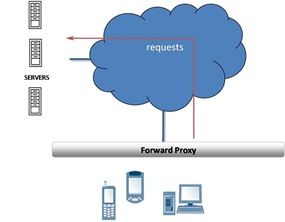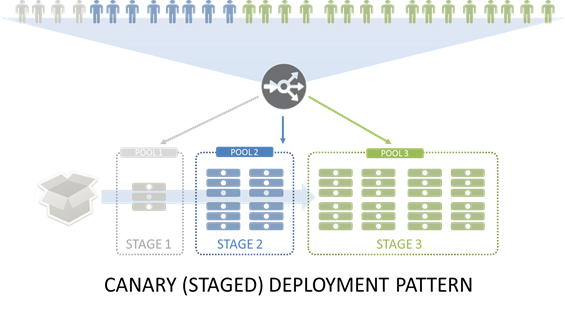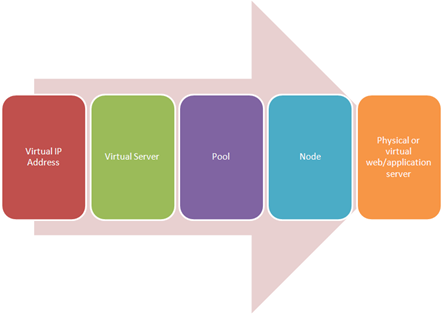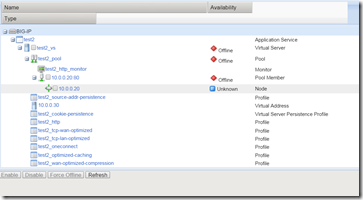application
107 TopicsMitigating OWASP Web Application Risk: Vulnerable and Outdated Components using F5 BIG-IP
This article provides information on the Struts 2 vulnerability (CVE-2017-5638) , one of the dangers posed by vulnerable and outdated components. It highlights how a single unpatched vulnerability in a widely used framework can lead to catastrophic consequences, including data breaches, server compromise, and damage to an organisation's reputation and how we can protect it using F5 BIG-IP Advanced WAF.198Views0likes0Comments2.5 bad ways to implement a server load balancing architecture
I'm in a bit of mood after reading a Javaworld article on server load balancing that presents some fairly poor ideas on architectural implementations. It's not the concepts that are necessarily wrong; they will work. It's the architectures offered as a method of load balancing made me do a double-take and say "What?" I started reading this article because it was part 2 of a series on load balancing and this installment focused on application layer load balancing. You know, layer 7 load balancing. Something we at F5 just might know a thing or two about. But you never know where and from whom you'll learn something new, so I was eager to dive in and learn something. I learned something alright. I learned a couple of bad ways to implement a server load balancing architecture. TWO LOAD BALANCERS? The first indication I wasn't going to be pleased with these suggestions came with the description of a "popular" load-balancing architecture that included two load balancers: one for the transport layer (layer 4) and another for the application layer (layer 7). In contrast to low-level load balancing solutions, application-level server load balancing operates with application knowledge. One popular load-balancing architecture, shown in Figure 1, includes both an application-level load balancer and a transport-level load balancer. Even the most rudimentary, entry level load balancers on the market today - software and hardware, free and commercial - can handle both transport and application layer load balancing. There is absolutely no need to deploy two separate load balancers to handle two different layers in the stack. This is a poor architecture introducing unnecessary management and architectural complexity as well as additional points of failure into the network architecture. It's bad for performance because it introduces additional hops and points of inspection through which application messages must flow. To give the author credit he does recognize this and offers up a second option to counter the negative impact of the "additional network hops." One way to avoid additional network hops is to make use of the HTTP redirect directive. With the help of the redirect directive, the server reroutes a client to another location. Instead of returning the requested object, the server returns a redirect response such as 303. I found it interesting that the author cited an HTTP response code of 303, which is rarely returned in conjunction with redirects. More often a 302 is used. But it is valid, if not a bit odd. That's not the real problem with this one, anyway. The author claims "The HTTP redirect approach has two weaknesses." That's true, it has two weaknesses - and a few more as well. He correctly identifies that this approach does nothing for availability and exposes the infrastructure, which is a security risk. But he fails to mention that using HTTP redirects introduces additional latency because it requires additional requests that must be made by the client (increasing network traffic), and that it is further incapable of providing any other advanced functionality at the load balancing point because it essentially turns the architecture into a variation of a DSR (direct server return) configuration. THAT"S ONLY 2 BAD WAYS, WHERE'S THE .5? The half bad way comes from the fact that the solutions are presented as a Java based solution. They will work in the sense that they do what the author says they'll do, but they won't scale. Consider this: the reason you're implementing load balancing is to scale, because one server can't handle the load. A solution that involves putting a single server - with the same limitations on connections and session tables - in front of two servers with essentially the twice the capacity of the load balancer gains you nothing. The single server may be able to handle 1.5 times (if you're lucky) what the servers serving applications may be capable of due to the fact that the burden of processing application requests has been offloaded to the application servers, but you're still limited in the number of concurrent users and connections you can handle because it's limited by the platform on which you are deploying the solution. An application server acting as a cluster controller or load balancer simply doesn't scale as well as a purpose-built load balancing solution because it isn't optimized to be a load balancer and its resource management is limited to that of a typical application server. That's true whether you're using a software solution like Apache mod_proxy_balancer or hardware solution. So if you're implementing this type of a solution to scale an application, you aren't going to see the benefits you think you are, and in fact you may see a degradation of performance due to the introduction of additional hops, additional processing, and poorly designed network architectures. I'm all for load balancing, obviously, but I'm also all for doing it the right way. And these solutions are just not the right way to implement a load balancing solution unless you're trying to learn the concepts involved or are in a computer science class in college. If you're going to do something, do it right. And doing it right means taking into consideration the goals of the solution you're trying to implement. The goals of a load balancing solution are to provide availability and scale, neither of which the solutions presented in this article will truly achieve.470Views0likes1CommentInside Look - PCoIP Proxy for VMware Horizon View
I sit down with F5 Solution Architect Paul Pindell to get an inside look at BIG-IP's native support for VMware's PCoIP protocol. He reviews the architecture, business value and gives a great demo on how to configure BIG-IP. BIG-IP APM offers full proxy support for PC-over-IP (PCoIP), a leading virtual desktop infrastructure (VDI) protocol. F5 is the first to provide this functionality which allows organizations to simplify their VMware Horizon View architectures. Combining PCoIP proxy with the power of the BIG-IP platform delivers hardened security and increased scalability for end-user computing. In addition to PCoIP, F5 supports a number of other VDI solutions, giving customers flexibility in designing and deploying their network infrastructure. ps Related: F5 Friday: Simple, Scalable and Secure PCoIP for VMware Horizon View Solutions for VMware applications F5's YouTube Channel In 5 Minutes or Less Series (24 videos – over 2 hours of In 5 Fun) Inside Look Series Life@F5 Series Technorati Tags: vdi,PCoIP,VMware,Access,Applications,Infrastructure,Performance,Security,Virtualization,silva,video,inside look,big-ip,apm Connect with Peter: Connect with F5:461Views0likes0CommentsThe Concise Guide to Proxies
We often mention that the benefits derived from some application delivery controllers are due to the nature of being a full proxy. And in the same breath we might mention reverse, half, and forward proxies, which makes the technology sound more like a description of the positions on a sports team than an application delivery solution. So what does these terms really mean? Here's the lowdown on the different kinds of proxies in one concise guide. PROXIES Proxies (often called intermediaries in the SOA world) are hardware or software solutions that sit between the client and the server and do something to requests and sometimes responses. The most often heard use of the term proxy is in conjunction with anonymizing Web surfing. That's because proxies sit between your browser and your desired destination and proxy the connection; that is you talk to the proxy while the proxy talks to the web server and neither you nor the web server know about each other. Proxies are not all the same. Some are half proxies, some are full proxies; some are forward and some are reverse. Yes, that came excruciatingly close to sounding like a Dr. Seuss book. (Go ahead, you know you want to. You may even remember this from .. .well, when it was first circulated.) FORWARD PROXIES Forward proxies are probably the most well known of all proxies, primarily because most folks have dealt with them either directly or indirectly. Forward proxies are those proxies that sit between two networks, usually a private internal network and the public Internet. Forward proxies have also traditionally been employed by large service providers as a bridge between their isolated network of subscribers and the public Internet, such as CompuServe and AOL in days gone by. These are often referred to as "mega-proxies" because they managed such high volumes of traffic. Forward proxies are generally HTTP (Web) proxies that provide a number of services but primarily focus on web content filtering and caching services. These forward proxies often include authentication and authorization as a part of their product to provide more control over access to public content. If you've ever gotten a web page that says "Your request has been denied by blah blah blah. If you think this is an error please contact the help desk/your administrator" then you've probably used a forward proxy. REVERSE PROXIES A reverse proxy is less well known, generally because we don't use the term anymore to describe products used as such. Load balancers (application delivery controllers) and caches are good examples of reverse proxies. Reverse proxies sit in front of web and application servers and process requests for applications and content coming in from the public Internet to the internal, private network. This is the primary reason for the appellation "reverse" proxy - to differentiate it from a proxy that handles outbound requests. Reverse proxies are also generally focused on HTTP but in recent years have expanded to include a number of other protocols commonly used on the web such as streaming audio (RTSP), file transfers (FTP), and generally any application protocol capable of being delivered via UDP or TCP. HALF PROXIES Half-proxy is a description of the way in which a proxy, reverse or forward, handles connections. There are two uses of the term half-proxy: one describing a deployment configuration that affects the way connections are handled and one that describes simply the difference between a first and subsequent connections. The deployment focused definition of half-proxy is associated with a direct server return (DSR) configuration. Requests are proxied by the device, but the responses do not return through the device, but rather are sent directly to the client. For some types of data - particularly streaming protocols - this configuration results in improved performance. This configuration is known as a half-proxy because only half the connection (incoming) is proxied while the other half, the response, is not. The second use of the term "half-proxy" describes a solution in which the proxy performs what is known as delayed binding in order to provide additional functionality. This allows the proxy to examine the request before determining where to send it. Once the proxy determines where to route the request, the connection between the client and the server are "stitched" together. This is referred to as a half-proxy because the initial TCP handshaking and first requests are proxied by the solution, but subsequently forwarded without interception. Half proxies can look at incoming requests in order to determine where the connection should be sent and can even use techniques to perform layer 7 inspection, but they are rarely capable of examining the responses. Almost all half-proxies fall into the category of reverse proxies. FULL PROXIES Full proxy is also a description of the way in which a proxy, reverse or forward, handles connections. A full proxy maintains two separate connections - one between itself and the client and one between itself and the destination server. A full proxy completely understands the protocols, and is itself an endpoint and an originator for the protocols. Full proxies are named because they completely proxy connections - incoming and outgoing. Because the full proxy is an actual protocol endpoint, it must fully implement the protocols as both a client and a server (a packet-based design does not). This also means the full proxy can have its own TCP connection behavior, such as buffering, retransmits, and TCP options. With a full proxy, each connection is unique; each can have its own TCP connection behavior. This means that a client connecting to the full proxy device would likely have different connection behavior than the full proxy might use for communicating with servers. Full proxies can look at incoming requests and outbound responses and can manipulate both if the solution allows it. Many reverse and forward proxies use a full proxy model today. There is no guarantee that a given solution is a full proxy, so you should always ask your solution provider if it is important to you that the solution is a full proxy.4.7KViews2likes12CommentsProgrammability in the Network: Canary Deployments
#devops The canary deployment pattern is another means of enabling continuous delivery. Deployment patterns (or as I like to call them of late, devops patterns) are good examples of how devops can put into place systems and tools that enable continuous delivery to be, well, continuous. The goal of these patterns is, for the most part, to make sure operations can smoothly move features, functions, releases or applications into production. We've previously looked at the Blue Green deployment pattern and today we're going to look at a variation: Canary deployments. Canary deployments are applicable when you're running a cluster of servers. In other words, you've got lots and lots of (probably active right now while you're considering pushing that next release) users. What you don't want is to do the traditional "we're sorry, we're down for maintenance, here's a picture of a funny squirrel to amuse you while you wait" maintenance page. You want to be able to roll out the new release without disruption. Yeah, that's quite the ask, isn't it? The Canary deployment pattern is an incremental upgrade methodology. First, the build is pushed to a small set of servers to which only a select group of users are directed. If that goes well, the release is pushed to a larger set of servers with a limited set of users. Finally, if that goes well, then the release is pushed out to all servers and all users. If issues occur at any stage, the release is halted - it goes no further. Hence the naming of the pattern - after the miner's canary, used because "its demise provided a warning of dangerous levels of toxic gases". The trick to implementing this pattern is two fold: first, being able to group the servers used in each step into discrete pools and second, the ability to direct specific sets of users to the appropriate pools. Both capabilities requires the ability to execute some logic to perform user-based load balancing. Nolio, in its first Devops Best Practices video, implements Canary deployments by manipulating the pools of servers at the load balancing tier, removing them to upgrade and then reinserting them for testing before moving onto the next phase. If your load balancing solution is programmable, there's no need to actually remove them as you can simply insert logic to remove them from being selected until they've been upgraded. You can also then insert the logic to determine which users are directed to which pool of servers. If the load balancing platform is really programmable, you can even extend that to determination to querying a database to determine user inclusion in certain groups, such as those you might use to perform AB testing. Such logic might base the decision on IP address (not the best option but an option) or later, when you're actually rolling out to a percentage of users you can write logic that randomly selects users based on location or their user name - like sharding, only in reverse - or pretty much anything you can think of. You can even split that further if you're rolling out an update to an API that's used by both mobile and traditional clients, to catch both or neither or specific types in an orderly fashion so you can test methodically - because you want to test methodically when you're using live users as test subjects. The beauty of this pattern is that allows continuous delivery. Users are never disrupted (if you do it right) and the upgrade occurs in a safely staged, incremental fashion. That enables you to back out quickly if necessary, because you do have a back button plan, right? Right?960Views1like1CommentX-Forwarded-For Log Filter for Windows Servers
For those that don't know what X-Forwarded-For is, then you might as well close your browser because this post likely will mean nothing to you… A Little Background Now, if you are still reading this, then you likely are having issues with determining the origin client connections to your web servers. When web requests are passed through proxies, load balancers, application delivery controllers, etc, the client no longer has a direct connection with the destination server and all traffic looks like it's coming from the last server in the chain. In the following diagram, Proxy2 is the last hop in the chain before the request hits the destination server. Relying on connection information alone, the server thinks that all connections come from Proxy2, not from the Client that initiated the connection. The only one in the chain here who knows who the client really is (as determined by it's client IP Address, is Proxy1. The problem is that application owners rely on source client information for many reasons ranging from analyzing client demographics to targeting Denial of Service attacks. That's where the X-Forwarded-For header comes in. It is non-RFC standard HTTP request header that is used for identifying the originating IP address of a client connecting to a web server through a proxy. The format of the header is: X-Forwarded-For: client, proxy1, proxy, … X-Forwarded-For header logging is supported in Apache (with mod_proxy) but Microsoft IIS does not have a direct way to support the translation of the X-Forwarded-For value into the client ip (c-ip) header value used in its webserver logging. Back in September, 2005 I wrote an ISAPI filter that can be installed within IIS to perform this transition. This was primarily for F5 customers but I figured that I might as well release it into the wild as others would find value out of it. Recently folks have asked for 64 bit versions (especially with the release of Windows 2008 Server). This gave me the opportunity to brush up on my C skills. In addition to building targets for 64 bit windows, I went ahead and added a few new features that have been asked for. Proxy Chain Support The original implementation did not correctly parse the "client, proxy1, proxy2,…" format and assumed that there was a single IP address following the X-Forwarded-For header. I've added code to tokenize the values and strip out all but the first token in the comma delimited chain for inclusion in the logs. Header Name Override Others have asked to be able to change the header name that the filter looked for from "X-Forwarded-For" to some customized value. In some cases they were using the X-Forwarded-For header for another reason and wanted to use iRules to create a new header that was to be used in the logs. I implemented this by adding a configuration file option for the filter. The filter will look for a file named F5XForwardedFor.ini in the same directory as the filter with the following format: [SETTINGS] HEADER=Alternate-Header-Name The value of "Alternate-Header-Name" can be changed to whatever header you would like to use. Download I've updated the original distribution file so that folks hitting my previous blog post would get the updates. The following zip file includes 32 and 64 bit release versions of the F5XForwardedFor.dll that you can install under IIS6 or IIS7. Installation Follow these steps to install the filter. Download and unzip the F5XForwardedFor.zip distribution. Copy the F5XForwardedFor.dll file from the x86\Release or x64\Release directory (depending on your platform) into a target directory on your system. Let's say C:\ISAPIFilters. Ensure that the containing directory and the F5XForwardedFor.dll file have read permissions by the IIS process. It's easiest to just give full read access to everyone. Open the IIS Admin utility and navigate to the web server you would like to apply it to. For IIS6, Right click on your web server and select Properties. Then select the "ISAPI Filters" tab. From there click the "Add" button and enter "F5XForwardedFor" for the Name and the path to the file "c:\ISAPIFilters\F5XForwardedFor.dll" to the Executable field and click OK enough times to exit the property dialogs. At this point the filter should be working for you. You can go back into the property dialog to determine whether the filter is active or an error occurred. For II7, you'll want to select your website and then double click on the "ISAPI Filters" icon that shows up in the Features View. In the Actions Pane on the right select the "Add" link and enter "F5XForwardedFor" for the name and "C:\ISAPIFilters\F5XForwardedFor.dll" for the Executable. Click OK and you are set to go. I'd love to hear feedback on this and if there are any other feature request, I'm wide open to suggestions. The source code is included in the download distribution so if you make any changes yourself, let me know! Good luck and happy filtering! -Joe15KViews0likes14CommentsNewton's First Law of Devops
#devops Deployment patterns enabling continuous delivery help align operations with development - and keep user frustration to a minimum One of the most difficult transitions for operations to make is the need to support releases more frequently. While most organizations will never match the velocity of a Facebook or Netflix, there is still a desire to eliminate the "reduced speed zone" most applications run into when trying to move into production. The reason for the reduced speed zone is the potential for downtime, not only for the application (version) being released but for other applications and services dependent on the same infrastructure. Misconfiguration is, after all, the leading cause of downtime in data centers across the globe. Thus, operations has good reason to be wary. And yet reducing the speed at which an application actually moves into production is exactly the opposite direction application development - and the business - want to go. They want to go faster, to be more agile, to release incrementally. Because application development rules today follow Newton's First Law of Motion: an object at rest stays at rest and an object in motion stays in motion with the same speed and in the same direction unless acted upon by an unbalanced force. Operations does not want to be that unbalanced force that stops the object. That's why we're seeing more "deployment patterns" or "devops patterns". That's why we're seeing an increasing need for programmability in the data path, i.e. in the network. Today, the complexity of infrastructure in production environments - the network, the application infrastructure, the point solutions, the services - impedes continuous deployment efforts by failing to meet devops need to not just automate, but implement the patterns and emerging architectures that keep deployments moving in the same direction and with the same speed as they are released by developers. These patterns depend on agility that is achieved primarily through programmability. Whether it's to implement blue-green deployments, a/b testing, versioning patterns or canary deployments - devops is in need of a devops platform, if you will, that will provide the programmability necessary to implement the deployment patterns that enable continuous delivery. A platform that eliminates the unbalanced force that has traditionally slowed down the release cycle, frustrating users and the business alike. That platform needs to be fast, flexible, and programmable. It needs to be able to bridge the gap between traditional and modern infrastructure. It needs to be API-enabled and yet easy to manage. More than anything else, that platform needs to exist.539Views0likes2CommentsWILS: Virtual Server versus Virtual IP Address
load balancing intermediaries have long used the terms “virtual server” and “virtual IP address”. With the widespread adoption of virtualization these terms have become even more confusing to the uninitiated. Here’s how load balancing and application delivery use the terminology. I often find it easiest to explain the difference between a “virtual server” and a “virtual IP address (VIP)” by walking through the flow of traffic as it is received from the client. When a client queries for “www.yourcompany.com” they get an IP address, of course. In many cases if the site is served by a load balancer or application delivery controller that IP address is a virtual IP address. That simply means the IP address is not tied to a specific host. It’s kind of floating out there, waiting for requests. It’s more like a taxi than a public bus in that a public bus has a predefined route from which it does not deviate. A taxi, however, can take you wherever you want within the confines of its territory. In the case of a virtual IP address that territory is the set of virtual servers and services offered by the organization. The client (the browser, probably) uses the virtual IP address to make a request to “www.yourcompany.com” for a particular resource such as a web application (HTTP) or to send an e-mail (SMTP). Using the VIP and a TCP port appropriate for the resource, the application delivery controller directs the request to a “virtual server”. The virtual server is also an abstraction. It doesn’t really “exist” anywhere but in the application delivery controller’s configuration. The virtual server determines – via myriad options – which pool of resources will best serve to meet the user’s request. That pool of resources contains “nodes”, which ultimately map to one (or more) physical or virtual web/application servers (or mail servers, or X servers). A virtual IP address can represent multiple virtual servers and the correct mapping between them is generally accomplished by further delineating virtual servers by TCP destination port. So a single virtual IP address can point to a virtual “HTTP” server, a virtual “SMTP” server, a virtual “SSH” server, etc… Each virtual “X” server is a separate instantiation, all essentially listening on the same virtual IP address. It is also true, however, that a single virtual server can be represented by multiple virtual IP addresses. So “www1” and “www2” may represent different virtual IP addresses, but they might both use the same virtual server. This allows an application delivery controller to make routing decisions based on the host name, so “images.yourcompany.com” and “content.yourcompany.com” might resolve to the same virtual IP address and the same virtual server, but the “pool” of resources to which requests for images is directed will be different than the “pool” of resources to which content is directed. This allows for greater flexibility in architecture and scalability of resources at the content-type and application level rather than at the server level. WILS: Write It Like Seth. Seth Godin always gets his point across with brevity and wit. WILS is an ATTEMPT TO BE concise about application delivery TOPICS AND just get straight to the point. NO DILLY DALLYING AROUND. Server Virtualization versus Server Virtualization Architects Need to Better Leverage Virtualization Using "X-Forwarded-For" in Apache or PHP SNAT Translation Overflow WILS: Client IP or Not Client IP, SNAT is the Question WILS: Why Does Load Balancing Improve Application Performance? WILS: The Concise Guide to *-Load Balancing WILS: Network Load Balancing versus Application Load Balancing All WILS Topics on DevCentral If Load Balancers Are Dead Why Do We Keep Talking About Them?3.2KViews1like1CommentMicroservices – application fragments need application services
Microservices are a cool way to build applications – cool in terms of the attention they get in blogs, marketing materials and conference speaking slots, but also cool in terms of genuinely offering a way to build applications that are more agile and robust than the monolithic architectures we have become used to. But really what are microservices? They are just fragments of an application. All the things we need from our monolithic applications we need from our fragments. Security, availability, performance. Each microservice needs to be up and running, have capacity and not be compromised if the integrity of the whole is to be preserved. Sure, there may be some services that are less critical than others, but in general you want all your services secure, fast, and available. How can you achieve this? Well there are number of ways, but the easiest is to reuse a common design pattern from the monolithic stack – an application proxy. Application proxies allow you to insert a layer of logic and control between the microservice client and the server. Pretty basic stuff. But by de-coupling the client from the server, you essentially virtualize the service. That means you can scale, protect and manage the service without disruption to the clients. You can provide capacity without complexity and security without slowing the application. Application traffic flow in microservices can be complex – multiple services need to be able to communicate to create the application. These complex flows can make application monitoring and security more complex to deliver – plus you need to code in client side discovery patterns if you need to scale out the number of instances supporting the service. Adding an application proxy – like a BIG-IP allow you to shrink or grow the processing power for a particular microservice – and add security, availability and optimization services inline. This can help you with segmentation, reporting and performance challenges. With a programmable, API-driven application proxy you can design a responsive system that is able to respond to changes in the environment and add additional application layer logic easily and without changing application code. With a strategic point of control like an application proxy - you can provide application services to your microservices, adding security and scalability while keeping the agility and performance you need.278Views0likes0Comments







